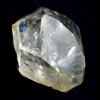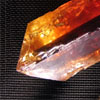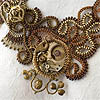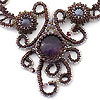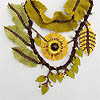February, 2010

Is winter over?It's hard to believe that a very long winter is coming to the end! In the February issue of MyLovelyBeads.com newsletter:
Imperial and other topazes
Contact us with any questions at
info@mylovelybeads.com.
Happy International Women's Day! Featured artist - Cindy Daniel Fashion Colorworks 2010 Inspired by computer games Step by step - beadwork on a loom March upcoming events Best regards,
MyLovelyBeads.com Team |
Imperial and other topazesTopaz as well as amethyst is a February gem, though amethyst is more known as this month birthstone. Topaz is colorless and transparent but is usually tinted by impurities; typical topaz is wine, yellow, pale gray or reddish-orange, and blue brown. It can also be made white, pale green, blue, gold, pink (rare), reddish-yellow or opaque to transparent/translucent. Orange topaz, also known as precious topaz, is the symbol of friendship, and the state gemstone for the US State of Utah. Blue topaz is the Texas state gemstone. Naturally occurring blue topaz is quite rare. Typically, colorless, gray or pale yellow and blue material is heat treated and irradiated to produce a more desired darker blue. Mystic topaz is colorless topaz that has been artificially coated giving it the desired rainbow effect. Imperial topaz is yellow, pink (rare, if natural) or pink-orange. Brazilian imperial topaz can often have a bright yellow to deep golden brown hue, sometimes even violet. Many brown or pale topazes are treated to make them bright yellow, gold, pink or violet colored. Some imperial topaz stones can fade on exposure to sunlight for an extended period of time. Topaz can be found at Topaz Mountain in western Utah, and in various areas including Ural and Ilmen mountains of Russia, in Afghanistan, Sri Lanka, Czech Republic, Germany, Norway, Pakistan, Italy, Sweden, Japan, Brazil, Mexico, Flinders Island and the United States. Some clear topaz crystals from Brazil can reach boulder size and weigh hundreds of pounds. Crystals of this size may be seen in museum collections. The Topaz of Aurungzebe, observed by Jean Baptiste Tavernier measured 157.75 carats. Colorless and light-blue varieties of topaz are found in Mason County, Texas within the Llano Uplift. During the Middle Ages topaz was thought to heal both physical and mental disorders and prevent death. The ancient Greeks believed topaz bestowed strength to its wearer. It was worn as an amulet to ward off enchantment, dispel sadness and strengthen intellect. The Romans believed it had power to improve eyesight. The Egyptians wore it as an amulet to protect them from injury; topaz was believed to assure beauty, fidelity and long life. Red and pink topaz gems were commonly used in the jewelry of the 18th and 19th Century Russian Czarinas and is why topaz is sometimes called "Imperial Topaz". |
||||||||||||||||
Happy International Women's Day!On March 8 we celebrate International Working Woman's Day, a major day of global celebration for the economic, political and social achievements of women. Started as a political event, the holiday blended in the culture of many countries. Today many events are held by women's groups around the world (some that even close off libraries to men). The global women's organization Aurora hosts a free worldwide register of IWD local events so that women and the media can locate local activity. Many governments and organizations around the world support IWD. For example, HSBC hosts a range of IWD activity including co-hosting of the United Kingdom's flagship IWD event with women's group Aurora. Global interest in IWD shows a steady increase. Happy holiday, dear friends! |
||||||||||||||||
Featured artist
Our featured artist in February is Cynthia Newcomer Daniel, a seed bead artist from California. We have known Cindy for a long time and must confess that her bead works amaze us, especially the last items. Great progress, great success! Cinthia says, "I've been called a "bead engineer," and while it is true that many of my pieces to require a good bit of engineering, I prefer to think of myself as a "bead explorer." I have been beading for most of my life; I started as a very young child. I can't remember my fist project; I feel as though I have always played with beads. When I was a very small child, I loved to string beads in different patterns; I remember enjoying how the beads appeared to change colors when placed next to different-colored beads. I also remember the great satisfaction it gave me to unstring the beads and put them away so that I could make new things with them. That's pretty much what still motivates me; though now, I am fortunate enough to have lots of bead beads. I don't have to take things apart any more in order to make new ones! I bead nearly every day for several hours a day, and I never get tired of it. I am still exploring color; I marvel at the effect that different finishes have on color relationships. A matte finish bead reacts very differently to its neighbors than a transparent bead; the same bead can look completely different when combined with beads of varying finishes and colors. I like to try out various combinations; some of them are wonderful, but others end up being taken apart and put away. I am often surprised by what works, and what doesn't. When I start a new piece, I start with a very small piece of the puzzle. I don't design a piece from the ground up; my process is more organic than that. I usually start with a small thought, "I wonder what would happen..." is the beginning of pretty much everything I have ever made. Once I have satisfied that thought, I look at what I have made; if I like it, I begin to wonder what would happen if I did this, then that, and then, before I know it, it has begun to be a necklace, or a bracelet, or some other piece of jewelry. If I don't like it, I take it to pieces. I love the freedom of being able to change direction and start over. In beading, nothing is ever wasted except thread; luckily, thread is cheap and easy to replace. Although I also enjoy metalwork, I don't find it as creatively satisfying as bead weaving; with beads, there are an infinite number of possibilities. And color. Did I mention that I love color?" Keep going, dear Cindy!
Beadwork by Cynthia Newcomer Daniel
|
||||||||||||||||
Fashion Colorworks 2010 started!Here we go! The first Fashion Colorworks 2010 Beading Contest is on its way! Shortly, beadworkers submit their 50% seed bead objects made in one of the three color combinations made up from fashion colors:
First color combination: Amparo Blue, Turquoise, Pink Champagne.
Second color combination: Tomato Puree, Fusion Coral, Violet. Third color combination: Dried Herb, Eucalyptus, Aurora. The official Fashion Colorworks 2010 rules are already published on MyLovelyBeads.com. Submit your entries! Contact us with any questions and suggestions at info@mylovelybeads.com. |
||||||||||||||||
Inspired by computer games
We're glad to feature another amazing beadworker, who creates stunning jewelry. Born in Russia, Elena Rasmussen, more known as Arbumillia, lives in Denmark. In 1988 she bought a small pack of expensive beads and made embroidery on her blouse, but she started working with beads 10 years later, in 1998, when during her visit to Russia Arbumillia got a book "Beadweaving" by Lyudmila Apolozova. As she says, since then she has a passion, a passion to enchanting glass beads and beadwork that has continued for more than 10 years. The first Arbumillia's artwork was Orchid Brooch made from beads and wire, but she didn't like wirework and didn't return to it later. She learned beading techniques by books and always experimented because she felt it was boring to replicate beadworks created by other artists. Arbumillia has made about 100 beadworks, sixty of them are presented on the www.arbumillia.pochta.ru website.
If you don't see the video please click here: Road To Kirasanct Arbumillia says, that her first serious work was collar Rogar Collar, which has never been showcased. It was a netting base of beige and pink color with many light-green and brown leaves. Then there was Zarah Necklace (shown in my gallery) featured a bunch of tree and a triangle piece of bark. After that Arbumillia began making original complicated items that take from 70 up to 150 hours. As she says, when working, she always thinks, "What if..." - and it helps to design new shapes and new elements. Arbumillia's principles in beadwork are: simplicity, lightness and flexibility. Arbumillia usually uses tiny glass seed beads, which are about 1-2 mm in diameter. She also likes working with 3, 6 and 8 mm crystals, bugle beads, gemstone beads, cabochons and other gemstones, and freshwater pearls. She always creates just a single copy of her designs, her favorite theme is nature: leaves, flowers and birds, so she prefers any shades of green. Elena says, that she is especially inspired by computer games and music where she is able to find unusual images. Magic, mystery, fantasy, adventures help Arbumillia reach uniqueness in beadwork. Probably because of that leading beadwork magazines publish her works, you can find Arbumillia's Land of Matissia Necklace in Bead&Button (January, 2009 issue), You Drive Me Insane Necklace will appear in B&B magazine in this year summer. So long, Arbumillia, we wish you success!
Beadwork gallery by Arbumillia
|
||||||||||||||||
Step by step - beadwork on a loom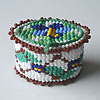
Beadwork techniques are broadly divided into loom and off-loom weaving, stringing, bead embroidery, bead crochet, and bead knitting. Another small tutorial by Victoria Katamashvili is on beadweaving, but about on-loom beadwork. Here you go!
How to weave beads on a loom
|
||||||||||||||||
Upcoming events
March 12, 13, 14, 2010 Juried Fine Art & Craft Festivals since 1976. Find the unique handcrafted artwork of thousands of American Artists! Decorative creations for home & garden, exceptional fine art & designer crafts! |
||||||||||||||||
Note
If you don't see the newsletter properly formatted please click here:
February Issue
|
||||||||||||||||
© 2010 MyLovelyBeads.com All Rights Reserved.
If you do not want receive our newsletter and you wish to remove your email address from our mailing list, please click the following link to unsubscribe.



